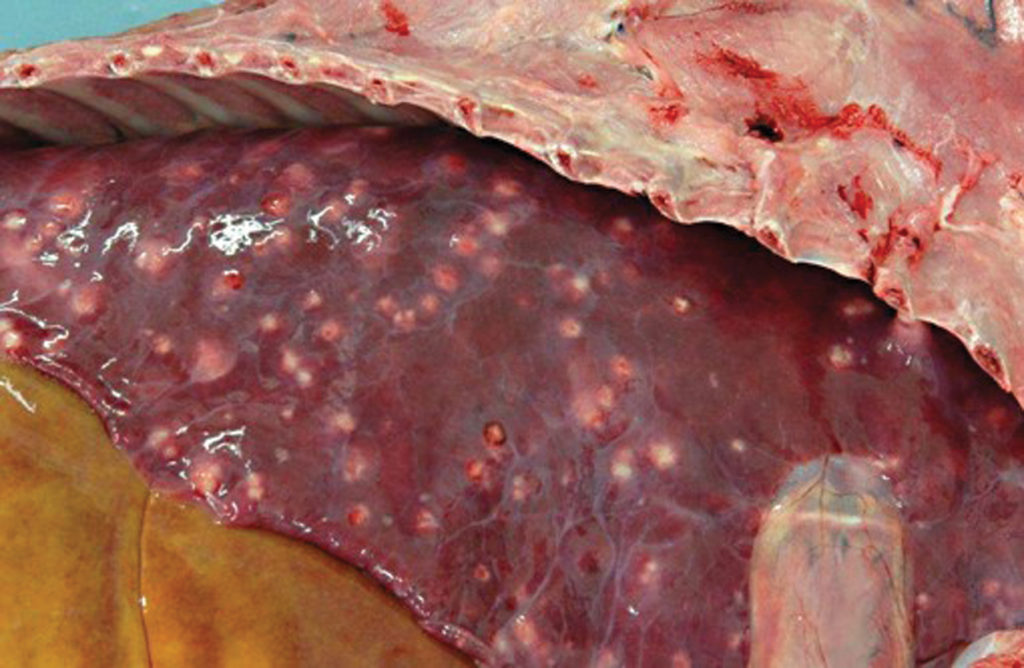Farm & Ranch
Rhodococcus Infections in the Foal

By Lauren Lamb, DVM
Rhodococcus pneumonia is one of the most common causes of pneumonia in foals one to four months of age. Rhodococcus equi (R. equi) is the bacterial that causes an infection in foals. R. equi infections are usually localized to the lungs and cause abscess formation within the lungs. Although rare, R. equi can also cause infection in other body systems such as the eye, bone, joints and abdomen (diarrhea or abscess). Adult horses rarely develop a R. equi, unless there is an underlying severe immunodeficiency present.
R. equi can be found on most horse farms globally. The R. equi can survive in the environment for long periods of time and withstand some of the harshest climates. Just because the bacteria is present in the soil does not automatically result in a foal becoming infected with R. equi. High stocking densities, low soil moisture and low pasture height can also increase the risk of a foal developing a R. Equi infection.
Rhodococcus equi has a relatively simple lifecycle. The bacteria is inhaled from the environment, usually in the form of dust. The airborne bacteria is transported to the lungs, where several abscesses are formed and the pneumonia begins. A secondary route of infection is via ingestion of bacteria, followed by entry of the bacteria into the blood stream. Once the bacteria is in the blood stream it will seed the lungs.
To read more pick up a copy of the April 2018 issue. To subscribe call 940-872-5922.

Radiographs of a three-month-old foals lungs infected with R. equi. (Photo courtesy of veteriankey.com)
Farm & Ranch
Ag Elsewhere: Wyoming

By Tressa Lawrence
Babies are tucked away in every nook and cranny. Many ranchers across Wyoming have baby animals popping up all over this time of year.
Farm & Ranch
Ag Elsewhere: Montana

By Lindsey Monk
Another load of grain in to keep feeding the calves until the green grass can really start popping.
Farm & Ranch
Meanwhile, Back at the Ranch….

By Rayford Pullen | [email protected]
Spring has sprung and hopefully the rains will continue where our country will heal from the previous droughts and our grasses will thrive. We are especially hopeful for the Panhandle of Texas where our neighbors and friends have been dealt a deadly blow to homes, ranges, livestock, and people. Keep them in your prayers as they will not be able to return to normal for many years if at all. Having lost their ability to benefit from this great cattle market is a double whammy for all of them.
Now is the time of year when we need to take care of business as it relates to our new calves that have been hitting the ground this spring. First and foremost is vaccinating for Blackleg followed by deworming with a white wormer and the IBR complex. Blackleg is a soil-born disease and with pastures extremely short this spring our calves have been grazing the green grass as soon as it shows itself, making them even more vulnerable to picking contaminates from the soil.
To read more, pick up a copy of the April issue of NTFR magazine. To subscribe by mail, call 940-872-5922.
-

 Country Lifestyles1 year ago
Country Lifestyles1 year agoScott & Stacey Schumacher: A Growth Mindset
-

 Equine7 months ago
Equine7 months agoThe Will to Win
-

 Country Lifestyles7 years ago
Country Lifestyles7 years agoStyle Your Profile – What your style cowboy hat says about you and new trends in 2017
-

 Country Lifestyles4 years ago
Country Lifestyles4 years agoAmber Crawford, Breakaway Roper
-

 HOME7 years ago
HOME7 years agoGrazing North Texas – Wilman Lovegrass
-

 Country Lifestyles7 years ago
Country Lifestyles7 years agoDecember 2016 Profile, Rusty Riddle – The Riddle Way
-

 Country Lifestyles8 years ago
Country Lifestyles8 years agoJune 2016 Profile – The man behind the mic: Bob Tallman
-

 Country Lifestyles8 years ago
Country Lifestyles8 years agoCowboy Culture with Clay Reid – Being a Man







